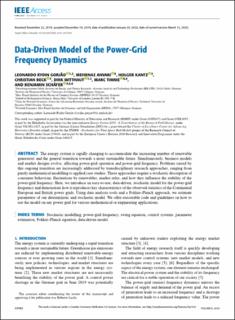| dc.contributor.author | Rydin Gorjao, Leonardo | |
| dc.contributor.author | Anvari, Mehrnaz | |
| dc.contributor.author | Kantz, Holger | |
| dc.contributor.author | Beck, Christian | |
| dc.contributor.author | Witthaut, Dirk | |
| dc.contributor.author | Timme, Marc | |
| dc.contributor.author | Schäfer, Benjamin | |
| dc.date.accessioned | 2022-08-26T12:04:44Z | |
| dc.date.available | 2022-08-26T12:04:44Z | |
| dc.date.created | 2022-06-05T13:15:48Z | |
| dc.date.issued | 2020-01-20 | |
| dc.identifier.citation | IEEE Access. 2020, 8 43082-43097. | en_US |
| dc.identifier.issn | 2169-3536 | |
| dc.identifier.uri | https://hdl.handle.net/11250/3013792 | |
| dc.description.abstract | The energy system is rapidly changing to accommodate the increasing number of renewable generators and the general transition towards a more sustainable future. Simultaneously, business models and market designs evolve, affecting power-grid operation and power-grid frequency. Problems raised by this ongoing transition are increasingly addressed by transdisciplinary research approaches, ranging from purely mathematical modelling to applied case studies. These approaches require a stochastic description of consumer behaviour, fluctuations by renewables, market rules, and how they influence the stability of the power-grid frequency. Here, we introduce an easy-to-use, data-driven, stochastic model for the power-grid frequency and demonstrate how it reproduces key characteristics of the observed statistics of the Continental European and British power grids. Using data analysis tools and a Fokker–Planck approach, we estimate parameters of our deterministic and stochastic model. We offer executable code and guidelines on how to use the model on any power grid for various mathematical or engineering applications. | en_US |
| dc.description.sponsorship | This work was supported in part by the Federal Ministry of Education and Research (BMBF) under Grant 03SF0472 and Grant 03EK3055, in part by the Helmholtz Association (via the joint initiative Energy System 2050 - A Contribution of the Research Field Energy, under Grant VH-NG-1025, in part by the German Science Foundation (DFG) by a grant toward the Cluster of Excellence Center for Advancing Electronics Dresden (cfaed), in part by the STORM - Stochastics for Time-Space Risk Models project of the Research Council of Norway (RCN) under Grant 274410, and in part by the European Union’s Horizon 2020 Research and Innovation Programme under the Marie Skłodowska-Curie under Grant 840825. | en_US |
| dc.language.iso | eng | en_US |
| dc.publisher | Institute of Electrical and Electronics Engineers | en_US |
| dc.relation.ispartofseries | IEEE Access;Volume 8, 2020 | |
| dc.rights | Navngivelse 4.0 Internasjonal | * |
| dc.rights.uri | http://creativecommons.org/licenses/by/4.0/deed.no | * |
| dc.subject | Stochastic modelling | en_US |
| dc.subject | Power-grid frequencies | en_US |
| dc.subject | Swing equations | en_US |
| dc.subject | Control systems | en_US |
| dc.subject | Parameter estimations | en_US |
| dc.subject | Fokker–Planck equation | en_US |
| dc.title | Data-driven model of the power-grid frequency dynamics | en_US |
| dc.type | Peer reviewed | en_US |
| dc.type | Journal article | en_US |
| dc.description.version | publishedVersion | en_US |
| cristin.ispublished | true | |
| cristin.fulltext | original | |
| cristin.qualitycode | 1 | |
| dc.identifier.doi | https://doi.org/10.1109/ACCESS.2020.2967834 | |
| dc.identifier.cristin | 2029580 | |
| dc.source.journal | IEEE Access | en_US |
| dc.source.volume | 8 | en_US |
| dc.source.issue | 8 | en_US |
| dc.source.pagenumber | 43082-43097 | en_US |
| dc.relation.project | Horisont 2020: EC/H2020/840825 | en_US |

